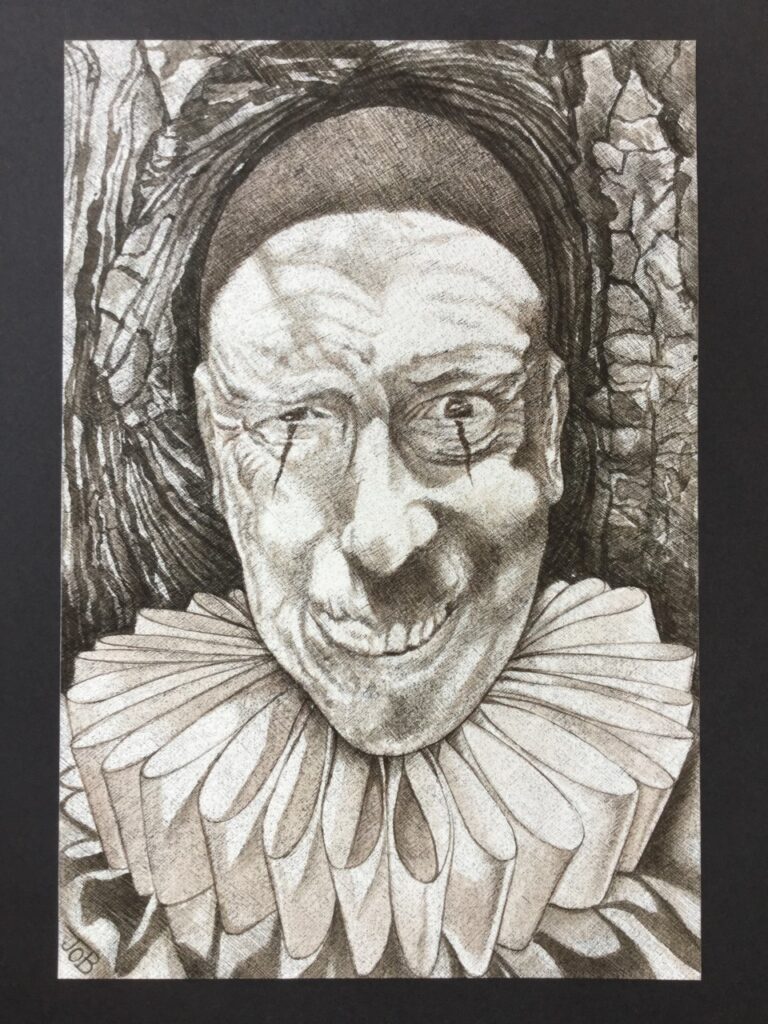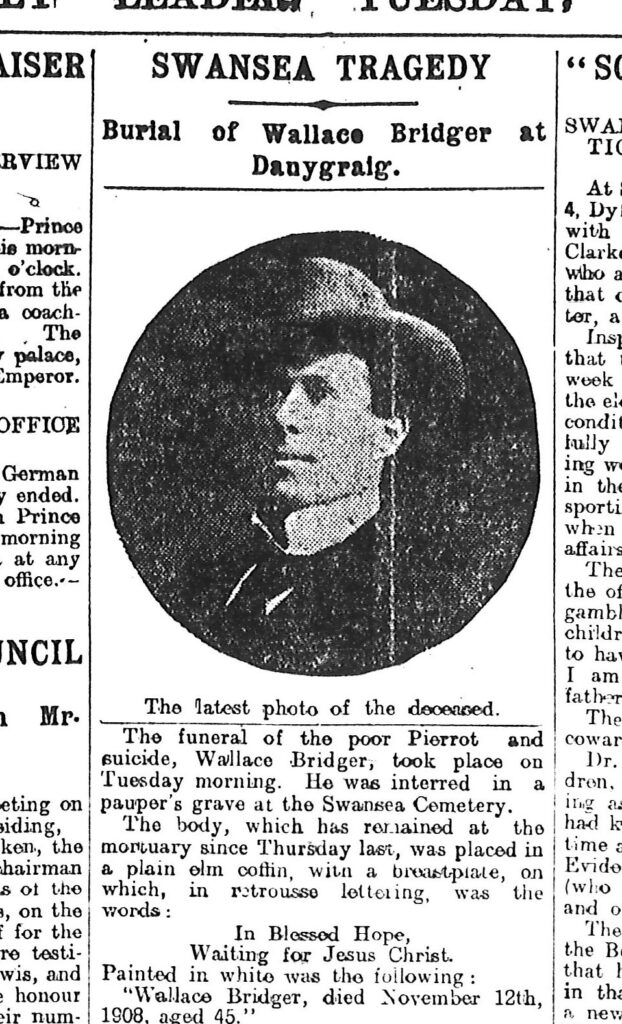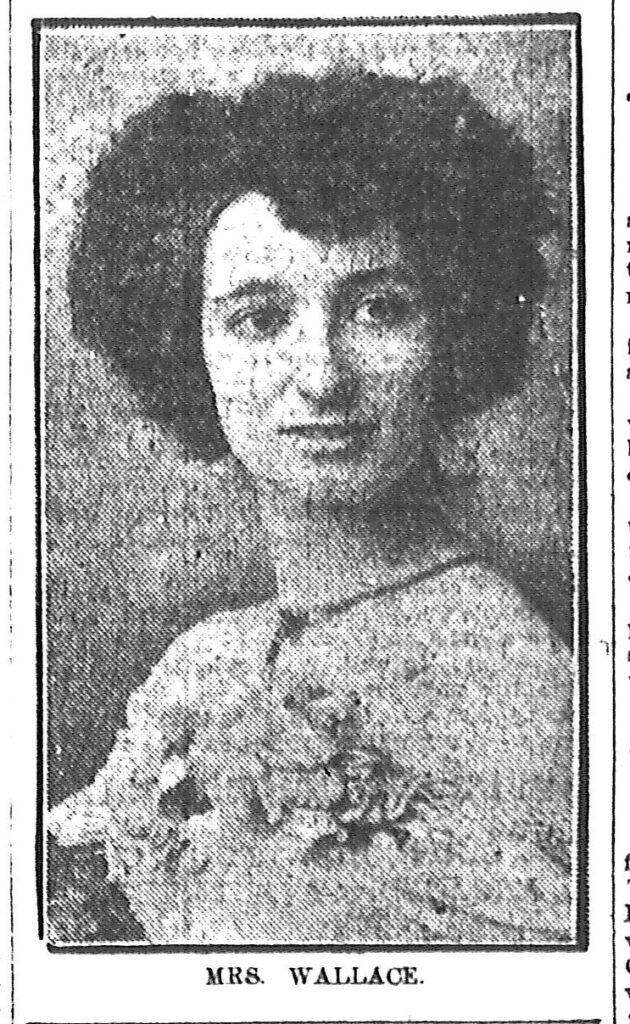THE TEARS OF A CLOWN

Walter Wallace had come to Swansea to murder his wife but these things never work out as you plan. He was driven slowly back upstairs by the police, who were understandably alarmed by the razor blade he held in one hand and the extremely unreliable revolver he had in the other. PC Bevan held a coal shovel in front of his face as a shield and forced Walter up into the attic. He was trapped.
He pulled the trigger but the gun wouldn’t fire so he threw it to the ground and drew the razor decisively across his throat.
He fell to the floor and within a few seconds he was dead.
On Friday 13 November 1908 he was a headline.
‘Fearful Tragedy at Swansea. Actor Attacks Wife and Slays Himself. Her Hair-Breadth Escape From Assassination. Baton Armed Constables Face the Revolver.’
For that brief moment, he finally achieved in death what had escaped him whilst he was alive.
And then he was buried at Danygraig Cemetery in Section L in an unmarked grave with no one present except the undertaker.

The Wallaces had been married for several years and had two children, Stella who was five and Walter who was three. They had arrived in Swansea in 1903, just another stop in an itinerant lifestyle. He worked as a comedian, a ventriloquist and a general music hall performer, touring provincial theatres, working pantomime and summer seasons as part of a pierrot troupe providing entertainment in Victoria Park and on Swansea beach. And a Pierrot? A basic pantomime character with a conical hat and the distinctive white face, suggesting the pallor of the dead.
Early in 1908 the Wallaces agreed to live apart. Walter rented a couple of rooms at 199 Kensington Crescent, now part of St Helen’s Avenue, though for much of the time he was touring and returned to Swansea infrequently. Eva Wallace lodged at No. 54 Trafalgar Terrace.
Walter returned to Swansea early in the morning of 12 October 1908 by train from Stoke where he was performing. He seems to have been hoping for a reconciliation with his wife Eva, having secured a pantomime season for them both for the winter. He had written her long and impassioned letters but her mind was made up. Whilst their marriage had initially been happy, something had happened. Walter, we are told, had been a loving father to the children but for some reason Eva wouldn’t let him see them. In his letters he pleaded for forgiveness. ‘Put the past behind us,’ he said. ‘Come back to me and I will do my utmost to make you happy.’ Eva however remained unmoved. She wanted nothing to do with him and hoped he would not trouble her again.

Walter visited a hotel in High Street and had an early morning glass of stout before going to Trafalgar Terrace. It was a difficult meeting. Eva told him that the children were at school but she wouldn’t tell him where and told him once again that their relationship was over.
So he told her he was leaving town for good and asked Eva to go to Kensington Crescent with him to sort through their possessions before he packed them up. She agreed and they went to the house with her landlady’s son Harold Coombs. He stayed downstairs whilst Walter and Eva went to his room to pack. Suddenly there were screams and Coombs rushed upstairs.
Wallace slammed the door against him but Harold picked up a bundle of stair-rods and forced his way into the room. He saw Wallace holding an old and rusty gun. He tried to shoot Eva but the gun misfired. He tried again. This time the gun went off. Perhaps he was as surprised as anyone else but from a range of only a few feet the bullet merely grazed Eva’s scalp.
He turned to shoot Harold but the boy threw the stair-rods into his face and ran for help. When the landlord appeared Wallace tried to shoot him too but again the gun failed. Harold then ran to the police in nearby Hospital Square. The landlord managed to rescue Eva in the face of Wallace’s threats and took her to the hospital. She was in ‘mortal terror that her husband would follow her and finish his work.’ But then the police arrived and very soon afterwards it was over.

So determined was the act that in less than two minutes the rash and unfortunate man was dead, a great pool of blood which had gushed out staining the floor for an area of several feet at the foot of the bed.
Eva’s injuries were slight. The shot had skimmed across her forehead. ‘It was only necessary for three stitches to be inserted.’ It was such a ramshackle gun that it was a wonder it went off at all.
At the inquest the cause of death was very straightforward. It was why he’d done it that was the puzzle. He had appeared recently with a company called May’s Smart Set with a dog which was central to his act, but the dog had died and Wallace was distressed at the loss of his friend and assistant. But was that really a reason to try and kill your wife? Especially in the opinion of the press she was as attractive as Eva. Reporters particularly liked her hair. The Cambrian Daily Leader described her as a respectable and accomplished woman with ‘a mass of dark hair dressed in thick curls.’ A Cardiff reporter decided she was blonde. Perhaps it was ever thus. They described her as a woman of private means but this wasn’t true. After dismissing Wallace she had taken a job as a barmaid at the Exchange Hotel on Adelaide Street to make ends meet.
There was a lot of excitement about a letter that was found in his pocket, the ‘rambling statement of a man suffering from imaginary troubles.’ Obviously the attack on Eva was premeditated, for he had previously written, in pencil and over several pages of blue foolscap, a torrent of unsubstantiated jealousy. The coroner wanted to protect Eva and so its contents were not revealed in open court. And since the official record of the inquest has been lost, we only have the scraps that the newspapers could report. What is interesting is that Wallace indicates that he had no problem with Eva’s men friends, but plenty with her women friends. The jury found that he had committed suicide whilst in a fit of temporary insanity.
Eva confirmed that ‘Professor Wallace’ was his stage name but that his real name was Wallace Bridger. It is when you explore census details that a different story emerges. Wallace was born in 1864 in Holloway and was married in Hertford in 1884 to Rebecca Howard who was working in service. They had a child together, a son also called Wallace, who died in infancy in Hitchen in 1886. By 1891 they were living in Stoke Newington when he described himself as a ‘hairdresser and ventriloquist,’ a fascinating combination. During the next few years he began his career in the music halls and Rebecca returned to service. In 1901 she was working as a house keeper in Pendleton in Lancashire. I think we can assume that they were no longer together.
Eva could not be Rebecca; she was only two years younger than Wallace. Eva believed that he was 35 years old, like her. In fact he was 45 years old and since Rebecca was still alive they could not have been married. The children were therefore illegitimate. Perhaps it is significant that Wallace never introduced her to his family. They had never heard of her.
We know that in 1903 they were lodging at 9 Bond Street in Swansea where Stella was born in September but Wallace’s itinerant life – forever at the bottom of the bill, always waiting for the big break – was not going well. In March 1904 the new father went to court because he hadn’t been paid for an appearance. He’d been engaged to provide entertainment whilst ‘Professor Richard’ worked as a ‘professor of electrical healing’ in Bristol. Walter’s job was to amuse and relax the audience during Prof Richards lectures whilst he ‘worked his cures.’ Prof Richard was distinctly unimpressed and so wouldn’t pay him. Walter, a new father, took him to court. Of course he lost. His complaint was not taken seriously and the judge enjoyed making a number of cheap jokes at his expense.
Money worries took him to court again in February 1905. Again it was about money.
He had been appearing in a touring production of the pantomime Dick Whittington but the company had not been paid. The impresario was Miss Daisy De Roy who was touring separately in her own production of Sinbad the Sailor and when the allegedly starving cast of Dick Whittington decided to divide the nightly takings from Workington and Widnes amongst themselves she was not best pleased. She terminated their contracts. They went to court in West Bromwich to recover their wages – and they won.
To be honest, it wasn’t a good season for Miss Daisy at all because she was taken to court again in Wandsworth the following month by the producer and manager of Dick Whittington, Neville Graham, over a shortfall in his own fees due to the sudden termination of the show. As he pointed out, it wasn’t his fault the ballet girls hadn’t been paid. Again she lost. It seems to have been a particularly ill-starred production. Daisy herself ended up suing a theatrical agent who had sent the wrong ‘scenic effects’ which apparently made a complete mockery of the Saucy Sally scene.
But there is something else here too. The dispute with Daisy had been led by Wallace – and his wife ‘Lena.’ Who was Lena? A typesetter’s mistake? Should it have read ‘Eva’? Or indeed Gina – short for Virginia, the name she used for Stella’s baptism? Or was it someone else entirely? Was Wallace parading around the Midlands with someone else whilst Eva was in Swansea looking after Stella? It doesn’t take much to imagine that the hopes he must have once cherished for fame and success were being shredded in pantomime. And whatever passing comfort he may have sought in cheap lodging houses with undernourished chorus girls, it brought merely disaster. Eva kicked him out. Perhaps she too sought solace elsewhere. And when she wouldn’t take him back Walter came to Swansea with a useless gun and a sharp razor.
And afterwards? I can not find her or the children in the census in 1911. The children re – emerge later. Stella married Fred Knapp in 1929 and died in Brent in 1980. Walter Cecil joined the Merchant Navy in 1918. But of Eva – whoever she might be – there is no trace. She effectively disappears.

This sad story was published in Minerva, the local history journal, but it hasn’t appeared anywhere else. It doesn’t feature in my Swansea Murders volume.
However, after a lot of pressure from eager readers, I have taken delivery of new stock of Swansea Murders which is available to buy now. The website price is £11.99 which is cheaper than Amazon. The price includes delivery and recycled packaging,
Go to the Swansea Murders page by clicking on this link or by using the menu for more information.
Or – go straight to the How to Buy page.